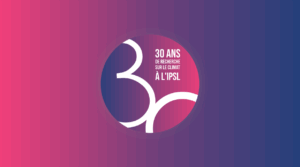Soutenance de thèse
Raphaël Lebrun
LMD
Modélisation du recouvrement vertical des nuages et impacts sur le rayonnement
Résumé
Radiative transfer is a crucial process in atmospheric and climate modelling, as well as for cli-
mate change simulations. Computations of radiative fluxes at the top of the atmosphere and at the
surface allow us to estimate the radaitive budget of the planet, which is very important to represent
correctly when it comes to climate simulations. Many elements interact with the radiation in the
atmosphere : gases, aerosols, clouds, and different types of surfaces (vegetation, oceans, snow…).
These different components do not interact in the same way with solar radiation, that comes from
the sun, and with infrared radiation, that comes from the earth’s surface and the atmosphere itself.
In both situations, clouds, composed of liquid water droplets and/or solid water crystals, represent
an important modeling difficulty. Clouds are complex objects, because of their composition, their
geometry, and their multiple interactions with the radiation field. Cloud-radiation interaction has
been studied for many years, and it has been shown that it represents one of the most important
obstacles to the improvement of global climate models.
In this work, we focus on one of the key aspects in the representation of the effect of clouds on
radiation : vertical cloud overlap. This notion is indeed directly linked to the cloud cover, which is
a quantity of first order importance in the calculation of the albedo of a cloud scene. Within the
framework of the vertical cloud overlap, we develop a formalism allowing us to explore in depth
various hypotheses of cloud overlap, in particular exponential-random overlap. We show that this
overlap hypothesis can, under certain conditions, allow a very good representation of cloud proper-
ties, both geometric and radiative, even from a coarse resolution vertical cloud profile. We show that
the vertical subgrid variability of the cloud fraction, although not taken into account by large-scale
atmospheric models, can have a significant impact on the solar fluxes calculated at the top of the
atmosphere. The rigorous consideration of vertical resolutions by the overlap is also an important
factor.
We then focus on incorporating these overlap results into a Monte Carlo radiative transfer code
(RadForce). The use of this new algorithm, which also uses a line-by-line approach for the different
atmospheric gases, allows us to model the emission altitudes of each atmospheric component. These
new tools allow us to analyze in a new way the radiative forcings linked to greenhouse gases, as
well as the impact of taking into account the vertical overlap of clouds and their vertical subgrid
heterogeneity.
Informations supplémentaires
Lieu
Amphithéâtre Durand, Bâtiment Esclangon, Jussieu, Sorbonne Université
Informations pour le lien Zoom :
Sujet : Soutenance de la thèse Raphael Lebrun
Heure : 23 juin 2023 14:00 Paris
Lien : https://cnrs.zoom.us/j/91068467908?pwd=NGkwWk52VDlwTzYrbUZITnllamR3Zz09
ID de réunion : 910 6846 7908
Code secret : Raphael3
Composition du jury
- Fleur Couvreux (CNRM) – Rapportrice
- Philippe Dubuisson (Université de Lille) – Rapporteur
- Céline Cornet (Université de Lille) – Examinatrice
- Robin Hogan (ECMWF) – Examinateur
- François Ravetta (LATMOS, Sorbonne Université) – Examinateur
- Frédéric Szczap (Université Clermont-Auvergne) – Examinateur
- Najda Villefranque (CNRM) – Invitée
- Jean-Louis Dufresne (LMD) – Directeur de thèse





